Give thrifted glassware a Jadeite glow up and new life by using acrylic craft paint. Easily sourced materials can be used to create a collection of Jadeite look glass. Use this guide to make DIY Faux Jadeite that looks like the real thing, but on a budget!
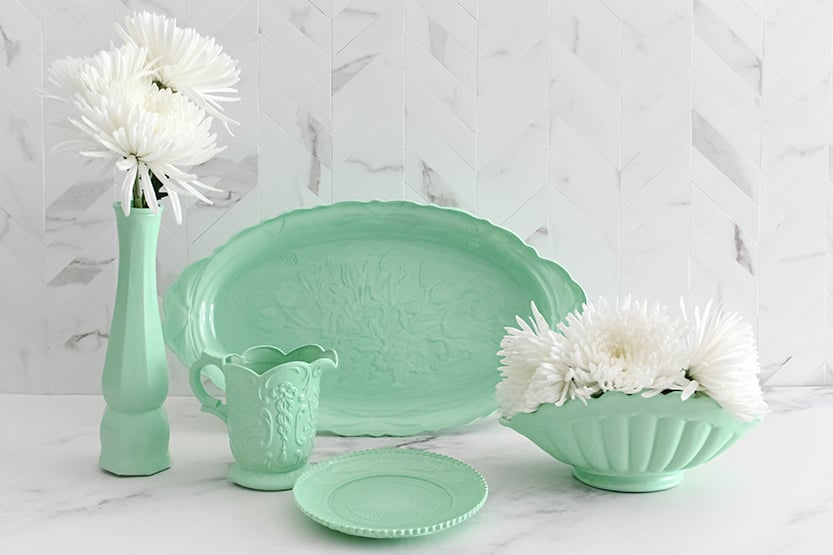
Genuine vintage jadeite is highly collectible these days and pieces can get pricey. If you love the look but don’t have a purist’s budget, try this technique to transform mass produced pressed glassware into a jadeite look. You might already have some of this glassware in the back of a cupboard, or you can find it consistently at yard sales. Thrift stores are a goldmine for vintage pressed glass, and can have a wide selection of inexpensive pieces available. All you need is the right paint and a few basic craft tools, along with some time and patience for the process.
A Brief History of Jadeite
The first familiar version of Jadeite is a jade green opaque glass introduced in 1930 as “Skokie” green by McKee Glass in Pennsylvania. It was created by adding scraps of green glass into their opaque milk glass formula. After 1932, Jeanette Glass began mass producing their version of the glass, but were first to coin the term “Jadite”. Early versions of jadeite glass by both these companies are actually types of uranium glass that will glow under a UV light. They only contain a very low, not unsafe level of uranium used as a colorant, though. Anchor Hocking began producing their brand called “Fire King Jadeite” in 1942, that did not contain uranium, since that element was needed for the war effort.
Jadeite was very popular during the Great Depression due to being easy to mass produce as pressed glass. It was appealing because it was inexpensive and sturdy, but pretty enough to display. Jadeite was cheerful, but had practical applications as well. It could be used as bakeware because of heat-resistant qualities, and it’s durability made it suitable for food storage. A line of jadeite serving ware was also created for use in restaurants and hospitals. It’s popularity endured through the 1940’s lean years of World War II rationing for all those reasons.
Peak production of vintage jadeite lasted from 1930-1950, but was still being produced through the 70’s as the popularity of this glassware waned for a few years. Their was a brief revival of interest in the 1970’s, with Fenton and Westmoreland Glass producing pieces as part of a “heritage” revival trend. Popularity fell off for a couple of decades, with some glass collectors even regarding it as “junk” glass!
The Current Trend
The current popularity of jadeite glass can be traced back to Martha Stewart, the original all-things-home influencer. Martha began to feature her extensive collection in her magazine and TV shows during the 1990’s and 2000’s. It could be said that this sparked a renewed interest in jadeite as a collectible, and drove prices for vintage jadeite up due to it’s popularity. Martha’s Green Glass, a new line of jadeite glass was produced exclusively for the Martha by Mail catalog from the late 90’s through 2004. This limited run created and manufactured by renowned American glassworks L.E. Smith, Fenton and Mosser became highly collectible as well.
More recently, a jadeite glass line was introduced by Joanna Gaines’ Hearth and and Hand Magnolia brand exclusively for Target. The hit show she co-hosted from 2013-208 with her husband Chip, “Fixer Upper” on HGTV has popularized the farmhouse chic style, feeding the appeal of jadeite glass even more.
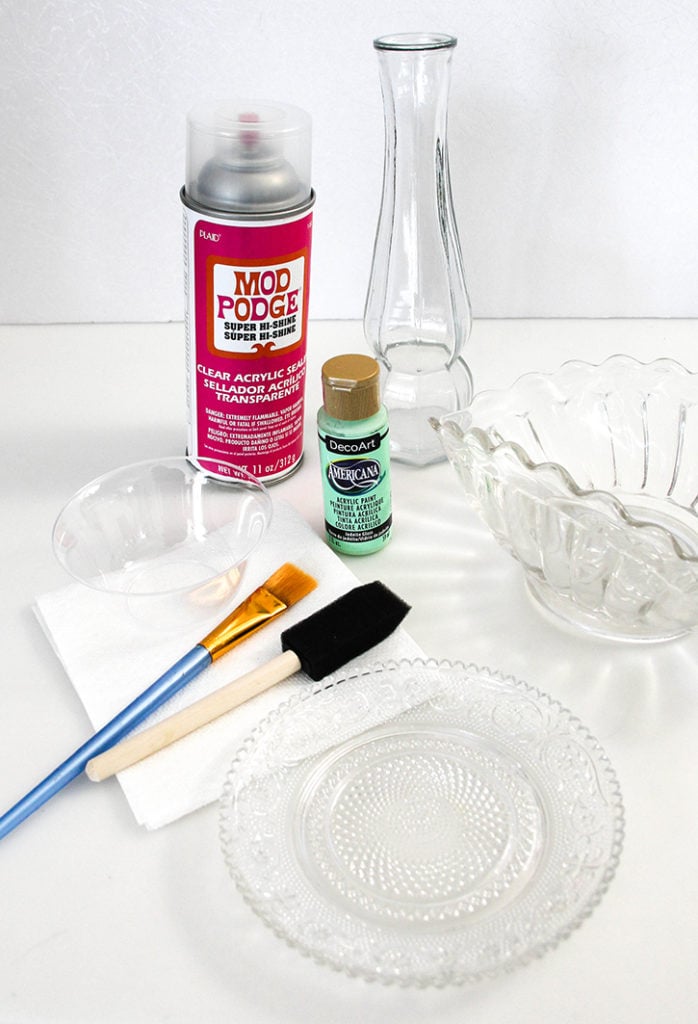
Painting Materials
You could use spray paint if you feel like this may speed up the process. This would be an okay option if you are really good with spray paint. But you have to be especially mindful of drips and having less control of the painting process. Spray paint can be messier to use, and it can be harder to evenly coat detailed areas. It can also be a chore to clean off overspray in areas you may not want painted.
For a project like this, hand painting by applying craft acrylic with brushes is really an easier process. I used DecoArt Americana acrylic paint in Jadeite Glass (the perfect color). I also used Mod Podge Super High-Shine clear acrylic sealer to protect the paint. These are readily available at most craft stores, or online. I also recommend a small sponge brush to apply the paint to glass, and one or two other soft craft brushes for touch-ups. You will also need a container of water to clean brushes between coats, and some paper towels to wipe away mistakes.
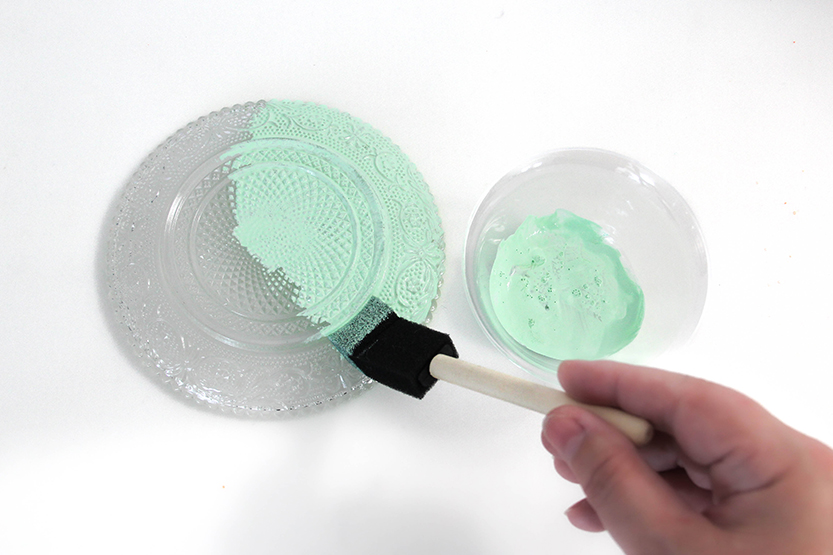
First Steps to creating DIY Faux Jadeite
Start with clean glass. Before you begin, make sure your glass pieces are free from stickers and sticker remnants. Thoroughly wash them to remove any dust or residues. Make sure the glass is dry before you begin to paint.
Use the sponge brush for at least the first coatings. It leaves a more even paint layer without brushstrokes, and can work well for filling in highly textured areas. Apply the paint to the surface as evenly as possible. Most glass will take at least two coats of paint to get an opaque finish, as acrylic craft paint is slightly transparent. Additional coats of paint may be required for larger, smoother pieces. Let each coat dry at least half an hour before adding more layers of paint. Once dry, the paint will scratch off easily on the glass surface, so handle with care. Wipe drips, smudges and overpainted spots away with a damp paper towel before the paint dries.
In the case of trays and plates that you might use for serving, paint only the back of the glass. This keeps the piece food safe and easier to keep clean. Wipe the glass to clean it, and do not submerge it in the sink or put in the dishwasher! Even after the paint is sealed, the finish can be delicate and can be damaged if not cleaned carefully.
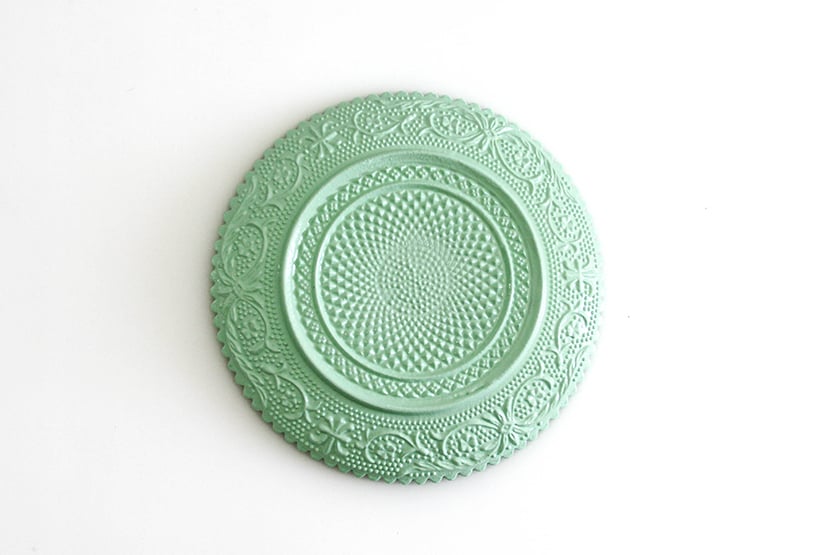
Details and textures that might have been less visible on the clear glass will really stand out after painting.
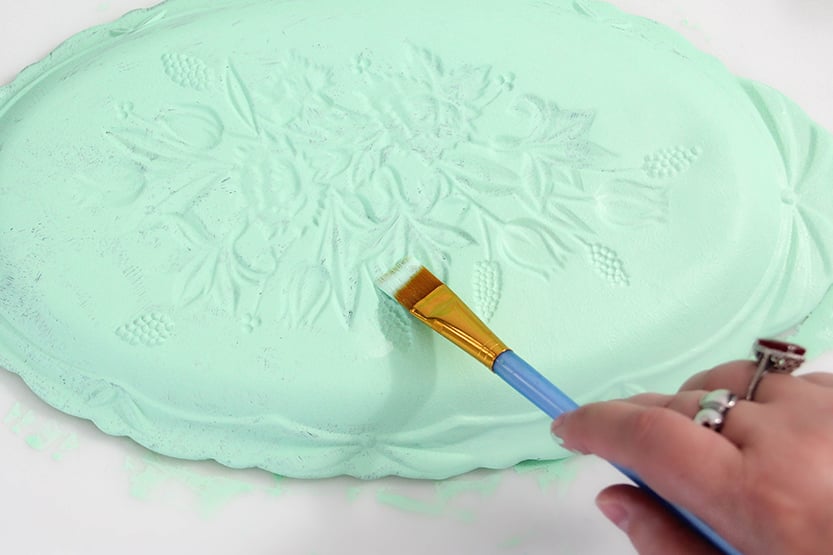
Finishing Touches
Use a soft paint brush for filling in textured areas or dimensional designs the sponge brush might have missed. It can also be used to touch up scratched or uneven areas in the finish. If you are meticulous about the finished look of the glass, you might want to paint scalloped edges on a piece of glassware using a smaller, finer brush.
After the final coat of paint, let the glassware cure overnight or 24 hours before applying the clear sealer. Only spray the painted areas with the sealer. It’s a good idea to mask off areas like the inside of a bowl or the front of a tray with tape and paper. This will protect the serving part of the piece from overspray, and give the piece a clean look as well as keeping it food safe. The product label on the sealer says to let dry 10 minutes between coats, but I would recommend about 30 minutes between coatings. I applied two coats of sealer to be thorough. Let the pieces cure for 24 hours before you start handling them.
Some Notes
To remove overspray on the unpainted surfaces, wipe the area with acetone nail polish remover on a clean rag or paper towel. Be sure to work in a well-ventilated area as there will be some fumes. You might want to wear chemical resistant gloves to do this. Handle acetone with care, and don’t spill it. Acetone can melt some plastics and synthetic fibers such as the ones used in carpet. Buff off any residue that is left on the smooth glass with a damp paper towel, then clean with glass cleaner.
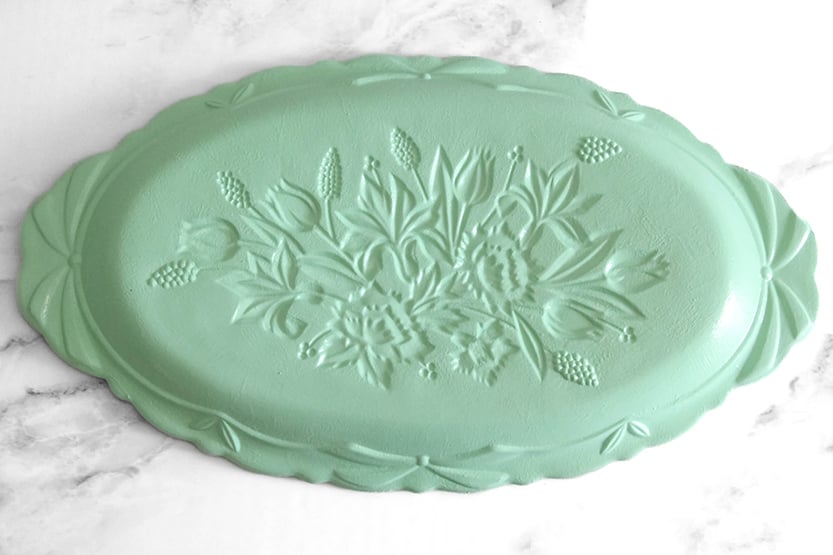
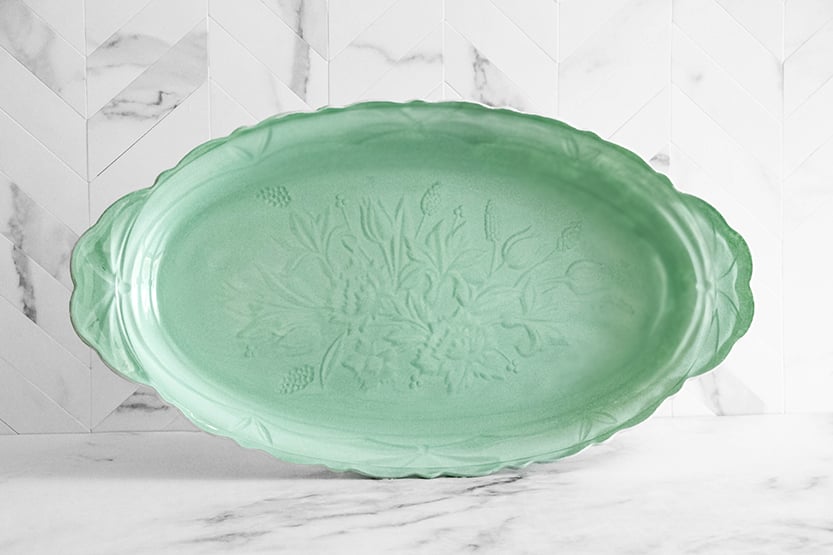
The DIY Faux Jadeite treatment transformed this contemporary glass tray into more of a 1940’s look. It’s amazing how painting the back of it brought out soft art deco lines in the handles and the scalloped edges. The modernist floral design on the back appears more dimensional through the transparent front of the glass.
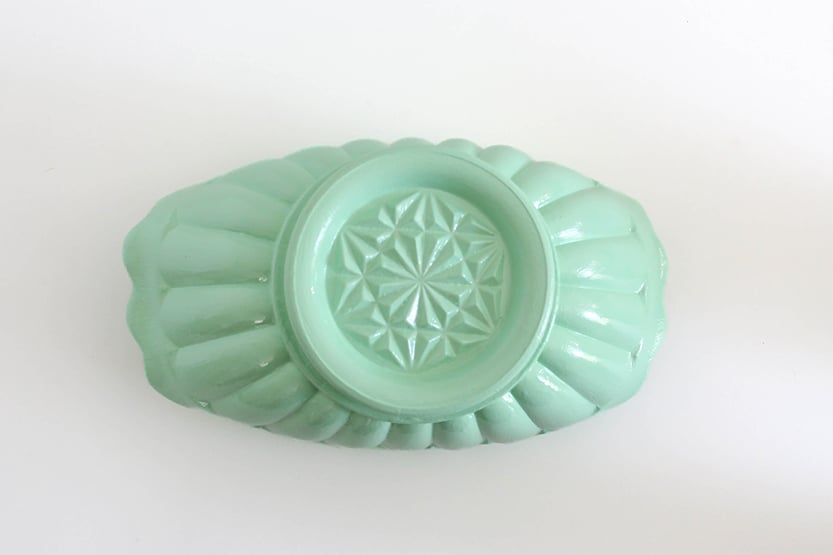
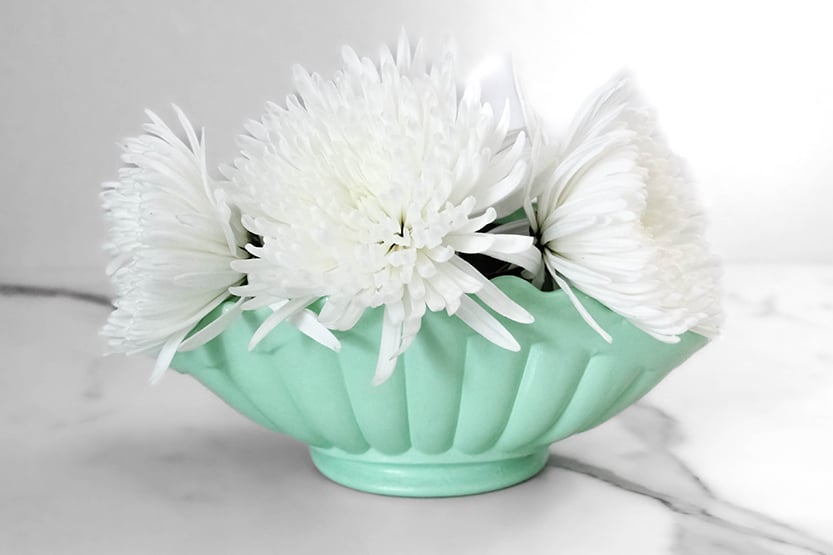
The lines of this folded bowl lend themselves well to the DIY Faux Jadeite glass look. Any simulated cut glass details will really stand out once the piece is painted.
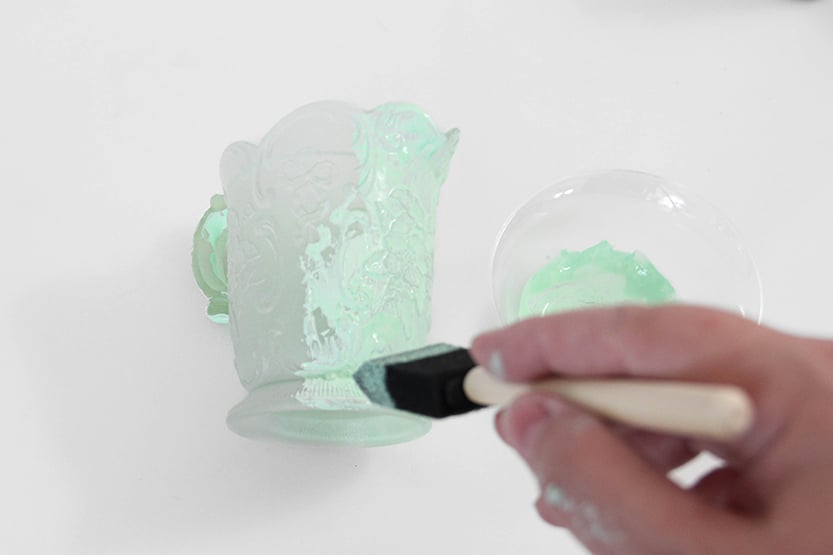
This small pitcher started out as piece of frosted glass. The beautiful floral design on it was barely visible, and was revealed by adding the jadeite paint. Don’t be afraid to use frosted glass, choose a piece you like for it’s style or detail. The frosted surface actually absorbs paint more easily. I left the inside of the pitcher unpainted so that it still has some practical use.
The Jadeite Look

Which of these pieces is genuine jadeite? You could build a pretty collection to display in your home without breaking the bank. At first glance, only a true collector could tell the difference! Try this hack for creating your own DIY Faux Jadeite with thrift store glass.
For another vintage upcycling project idea, try your hand at this Keepsake Box Makeover.
